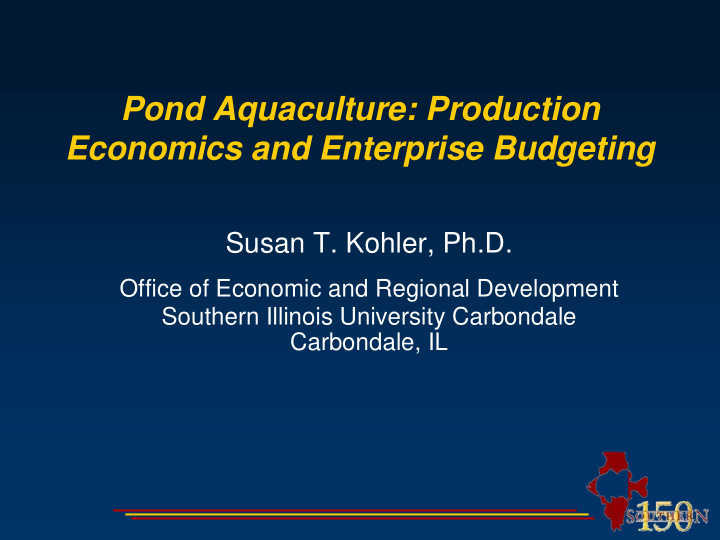



Pond Aquaculture: Production Economics and Enterprise Budgeting Susan T. Kohler, Ph.D. Office of Economic and Regional Development Southern Illinois University Carbondale Carbondale, IL
HAVE YOU MADE AN ESTIMATE OF HAVE YOU MADE AN ESTIMATE OF INVESTMENT COSTS, OPERATING INVESTMENT COSTS, OPERATING COSTS AND RETURNS? COSTS AND RETURNS?
WILL THE EXPECTED PROFIT WILL THE EXPECTED PROFIT PROVIDE AN ADEQUATE RETURN PROVIDE AN ADEQUATE RETURN FOR YOUR LABOR, FOR YOUR LABOR, MANAGEMENT AND RISK? MANAGEMENT AND RISK?
• Investment or capital costs COSTS TO CONSIDER COSTS TO CONSIDER • Variable costs • Fixed costs
INVESTMENT REQUIREMENTS INVESTMENT REQUIREMENTS Capital and construction costs that must be committed before the first fish is stocked
INVESTMENT REQUIREMENTS INVESTMENT REQUIREMENTS • Land • Tractor • Pond construction • Mower • Drain pipe & fittings • Oxygen meter • Wells / water supply • Water testing equipment • Water pumps and pipes • Seines • Electric power lines • Dip nets • Aerators • Feed wagon/blower • Boat and motor • Waders and boots • Hauling tanks & agitators • Baskets and buckets • Truck • Storage buildings • Feed storage bins • Miscellaneous equipment
Costs which vary with the level of VARIABLE COSTS VARIABLE COSTS production
VARIABLE COSTS VARIABLE COSTS • Fingerlings • Electricity • Feed • Fuel • Interest on operating • Chemicals capital • Sales / harvest costs • Labor • Office equipment • Repair & maintenance of • Repair & maintenance of equipment equipment
FIXED COSTS FIXED COSTS Costs which once the enterprise is underway, are incurred regardless of the level of production
FIXED COSTS FIXED COSTS • Interest on investment • Depreciation • Permits • Licenses • Property taxes • Insurance
VARIABLE- -FIXED COST RATIO FIXED COST RATIO VARIABLE Fixed Cost Fixed Cost (15- -17%) 17%) (15 Variable Cost (83- -85%) 85%) Variable Cost (83
BREAKDOWN OF VARIABLE COSTS BREAKDOWN OF VARIABLE COSTS FOR A CATFISH OPERATION FOR A CATFISH OPERATION Fingerlings Fingerlings Chemicals - Chemicals - 6% 6% 15% 15% Electricity - - 5% 5% Electricity Feed - - 64% 64% Feed Other Costs Other Costs 21% 21% Interest - - 4% 4% Interest Repairs - - 3% 3% Repairs Misc. - Misc. - 3% 3%
MAJOR INVESTMENT AND MAJOR INVESTMENT AND OPERATING COSTS OPERATING COSTS • Land • Pond construction • Water • Equipment • Fingerling costs • Feed costs • Electricity and fuel • Labor
• What is the cost of suitable land for • Is the land a current asset? LAND LAND fish farming?
LAND LAND • 80-85% of the total land area will be used for ponds • 15-20% will be in levees, drains, storage areas, etc.
POND CONSTRUCTION POND CONSTRUCTION • Drainage structures • Vegetative cover • Dirt moving • Gravel
• Dependable supply of water free of fish WATER SUPPLY WATER SUPPLY and pollutants
WATER IS NEEDED TO: WATER IS NEEDED TO: • Fill the ponds • Compensate for evaporation and seepage • Improve pond water quality
WATER WATER • HSB culture requires more water than catfish production • Flow rate of 35 gallons per minute per water acre
• A flow rate of 35 gallons per minute per WELL SIZE WELL SIZE water acre
EQUIPMENT EQUIPMENT • Greater than 80% of the equipment used on a fish farm is specialized aquaculture equipment such as aerators, feeders, harvesting equipment, and water quality testing equipment
• One electrical aerator and one-third use of an emergency aerator per pond EQUIPMENT EQUIPMENT
HSB FINGERLINGS HSB FINGERLINGS • The price of one gram fingerlings over the past five years has been around $0.20 each
FEED COSTS FEED COSTS • Bulk feed costs average $560/ton • Protein content derived from fish and soybean meal • Average feed conversion is 2 to 2.5
ELECTRICITY AND FUEL ELECTRICITY AND FUEL Primarily used for: • Aeration • Water movement • Feeding • Mowing
• Increased aeration demands drive up ELECTRICITY AND FUEL ELECTRICITY AND FUEL fuel costs
• Transferring & harvesting • Day-to-day operations LABOR LABOR • Management
LABOR LABOR • Increased labor required to receive and transfer fingerlings, feed, monitor water quality, harvest and arrange sales and transport
RULE OF THUMB RULE OF THUMB • You can expect to spend at least $5,000 per acre before you sell your first fish • It will probably take at least 18 months from the time you begin pond construction before any fish are large enough to harvest Source: Catfish Farmer’s Handbook, Cooperative Extension Service, Mississippi State University
• Grow with success CONCLUSION CONCLUSION • Gain knowledge • Start small • Plan
Recommend
More recommend